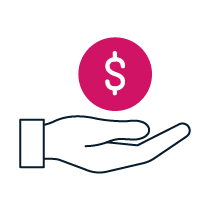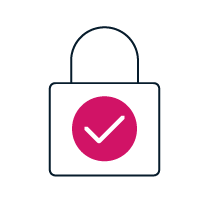The Relationship Between Blockchain and Cryptocurrency
Blockchain and cryptocurrency are terms you’ll often hear used together. While they are two distinctly different technologies, they are also inherently intertwined with one another.
Essentially a digitalized, decentralized, public ledger, blockchain is a formation of digital information, or blocks, stored across a network of computers creating a database. When verifiable transactions take place, the information is stored in blocks, which, when full, are added to the chain.1 Cryptocurrency operates through the blockchain, as it too is a decentralized, digital system. Defined as a digital or virtual currency, crypto uses cryptography for security and is not owned by any particular authority, making it difficult for governments to manipulate.2
Bitcoin was the first cryptocurrency, but the list has subsequently mushroomed to more than 10,000.3 Blockchain technology was, in fact, popularized as the foundation for Bitcoin.4 Despite many doubts and a lot of skepticism, both technologies have become an important part of our economic systems for the foreseeable future. Much has changed and advanced in recent years, but with the terms so closely aligned, a great deal of confusion still exists.
Mitigate the confusion and learn how to critically assess the viability of any crypto project with the cryptocurrency course from MIT Media Lab.
How blockchain and cryptocurrency work together
Rather than being an optional technology for cryptocurrency, blockchain is a foundational feature of it. Ultimately, the growth and development of blockchain has been fuelled by cryptocurrencies, as crypto relies on its network to exist. But blockchain transcends cryptocurrency applications. Not restricted to the financial sector, the technology offers multiple solutions that have already, and will continue to, disrupt diverse markets in the years to come.5
The terms have become synonymous, perhaps because the first blockchain was the database on which every bitcoin (the first cryptocurrency) transaction was stored. When blockchain was first implemented in 2009, it wasn’t known as such. It assumed its name because of the way the transactions were grouped into blocks of data, then chained together by way of a mathematical function that creates a hash code.6 The concept of a cryptographically secured chain of information blocks had originally been envisaged in 1982, then developed in the early 1990s, but it was this revolutionary original cryptocurrency that brought the system to prominence.7
For those seeking a greater focus on cryptocurrency, the University of Cape Town (UCT) offers the Blockchain and Digital Currency: The Future of Money online short course. This six-week online short course will expand your working knowledge of blockchain and cryptocurrency, and reveal how crypto assets are set to shape the future of the financial industry.
Innovative applications of blockchain
You don’t need to look far to come up with a list of innovative ways in which blockchain technology is being applied. A wide range of fields, including healthcare, real estate, government, and music are finding a use for blockchain’s powerful, secure way of storing, verifying, and encrypting data.8 Here are seven more applications of blockchain technology, some of which are underscored by cryptocurrencies:
Finance

One of the main services of the financial sector is to store money and transfer it from one entity to another. This requires a trustworthy intermediary, in the form of a bank. Blockchain is now effectively eliminating the need for such intermediaries by decentralizing transactions. By moving the means of transaction out of siloed, closed networks, blockchain is helping to solve some of the challenges around the interoperability of disparate financial systems around the world.9
The ability to track all transactions increases the transparency and security of blockchain-based payments too. This is beneficial both to the parties of a transaction and to relevant regulators.10
Smart contracts

Smart contracts act as self-executing programs, triggered automatically when predetermined conditions are met, that facilitate the terms of agreement between the seller and buyer directly. As they are executed on a blockchain network, the transactions are trackable, transparent, and irreversible.11 This type of automation can significantly boost productivity while slashing costs in business. Put simply, it helps you exchange property, shares, legal documents, or anything of value in a manner that’s transparent and free of conflict, while also avoiding the expense of a middleman.12
Cybersecurity

Data stored on blockchain is rendered tamper-proof because the network of nodes (the disparate computers on which the shared database is stored, and which validate transactions) can cross-reference to locate the source of a disputed change, so the technology has a number of potential cybersecurity applications. Storing information across a network of devices reduces the risk of a hacker exploiting a single point of vulnerability. Similarly, decentralizing control of edge devices (which provide an entry point into enterprise or service provider core networks) and Internet of Things devices can render these devices more secure against attacks.13
Health records

A decentralized, secure, trustworthy blockchain system has clear applications for the storage of healthcare records. Personal health records (PHR) collect data from sources including medical centers, devices, clinics, and pharmacies, and are primarily managed by patients. Electronic health records (EHR) are digital records of patients’ medical history, and are managed by doctors.14
As patients manage PHRs, the validity of that information is sometimes doubted. Storing them on blockchains would ensure they are traceable, transparent, unchangeable, auditable, and secure.
EHRs, on the other hand, are typically stored in centralized legacy systems, which may not be interoperable between different healthcare facilities. Blockchain could offer a solution, with EHRs stored securely on a decentralized system that can be accessed – by both patients and healthcare workers – across systems and organizations.15
Non-fungible tokens

NFTs, as they’re more commonly known, are tokens on blockchains, but they differ from cryptocurrencies in that they are unique digital assets.16 Technically, NFTs can represent ownership of anything, but they are mostly used to buy and sell digital art. In many cases, this digital art already exists and is freely available on the internet for anyone to view, buy, or download. What an NFT confers is ownership of that art. Think of it as the difference between owning an original painting and a print of it.17
Voting

Recording and storing high-value, high-volume pieces of data is inherent to the voting process. This makes blockchain an ideal technology for updating the voting system. Because all nodes on a blockchain must verify any information entered onto it, people could potentially cast their votes online without fear of fraud. It also creates greater certainty for electoral officials, who can tally votes certain in the knowledge that each is attributable to only one individual.18
The future of cryptocurrencies and blockchain
The worldwide spend on blockchain is forecasted to reach $104.9 billion in 2028.19 With blockchain start-ups and traditional institutions increasingly seizing the momentum this technology provides, blockchain and cryptocurrencies are providing disruptions far beyond the financial services sector. The pace of the technology’s evolution shows no sign of slowing down.
While there are those who remain uncertain of cryptocurrency’s future, 2021 is seen by many as a breakthrough year for their investment profile.20 Whether or not it’s a good long-term investment is still to be determined. Some see Bitcoin’s fixed supply as a reason it will appreciate over time, while the broad ecosystem of decentralized applications being developed on the Ethereum blockchain platform should increase its value in the long run.21
To keep abreast of the latest blockchain developments, explore the MIT Sloan School of Management’s six-week Blockchain Technologies: Business Innovation and Application online short course. This online program examines the fundamental changes that blockchain brings to business and economics, and will equip you with the tools to leverage blockchain technology to drive innovation and efficiency in your organization. Learn more about what you can expect on the course here.
Learn how blockchain can address your business challenges
- 1 Conway, L. (Nov, 2021). ‘Blockchain explained’. Retrieved from Investopedia.
- 2 (Nd). ‘What is cryptocurrency? A beginner’s guide to digital currency’. Retrieved from Cointelegraph. Accessed November 22, 2021.
- 3 Conway, L. (Nov, 2021). ‘10 Important cryptocurrencies other than Bitcoin’. Retrieved from Investopedia.
- 4 Sheldon, R. (Aug, 2021). ‘A timeline and history of blockchain technology’. Retrieved from WhatIs.com.
- 5 Clark, M. (Sep, 2021). ‘Blockchain, explained’. Retrieved from The Verge.
- 6 Iredale, G. (Nov, 2020). ‘History of blockchain technology: A detailed guide’. Retrieved from 101 Blockchains.
- 7 (Nd). ‘What’s the difference between blockchain and Bitcoin?’. Retrieved from Euromoney. Accessed November 22, 2021.
- 8 Daley, S. (Oct, 2021). ‘34 Blockchain applications and real-world use cases disrupting the status quo’. Retrieved from Built In.
- 9 Dixon, D. (Apr, 2021). ‘How blockchain technology is fixing payments today and what comes next’. Retrieved from World Economic Forum.
- 10 England, J. (Oct, 2021). ‘Blockchain boom: Secure payment solution or passing trend?’. Retrieved from Fintech Magazine.
- 11 (Nd). ‘What are smart contracts on blockchain?’. Retrieved from IBM. Accessed November 24, 2021.
- 12 (Sep, 2021). ‘What is a smart contract?’. Retrieved from Chainlink.
- 13 Singh, S. (Jul, 2021). ‘Potential use cases of blockchain technology for cybersecurity’. Retrieved from IT Business Edge.
- 14 Kenney, S. (Oct, 2021). ‘Blockchain has potential for the future of personal health records, electronic health records’. Retrieved from Pharmacy Times.
- 15 Miller, J. (Jul, 2021). ‘How blockchain can be used for personal health record storage and security’. Retrieved from HIMSS.
- 16 Clark, M. (Aug, 2021). ‘NFTs, explained’. Retrieved from The Verge.
- 17 Conti, R. (May, 2021). ‘What you need to know about non-fungible tokens (NFTs)’. Retrieved from Forbes.
- 18 Liebkind, J. (Dec, 2020). ‘How blockchain technology can prevent voter fraud’. Retrieved from Investopedia.
- 19 (Sep, 2021). ‘Blockchain market size, share & COVID-19 impact analysis’. Retrieved from Fortune Business Insights.
- 20 Haar, R. (Nov, 2021). ‘The future of cryptocurrency: 5 Experts’ predictions after a “breakthrough” 2021’. Retrieved from NextAdvisor.
- 21 Levy, A. (Oct, 2021). ‘Is cryptocurrency a good investment?’. Retrieved from The Motley Fool.
